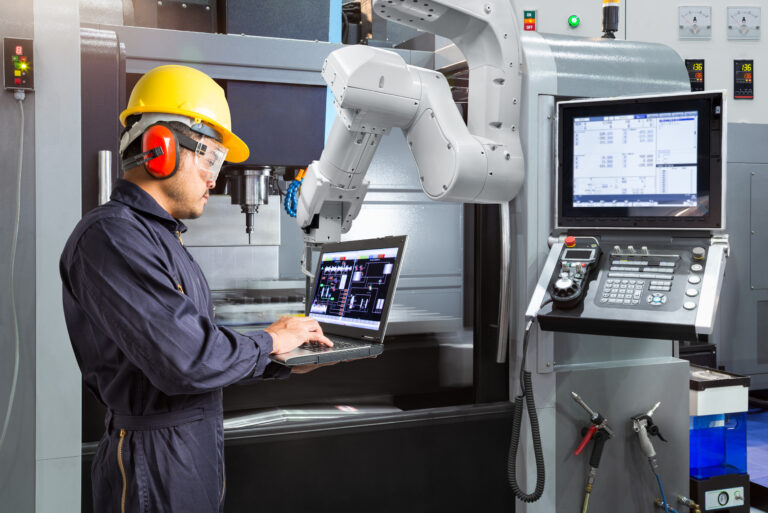
When a system, process, or institution experiences change so profound that it completely alters how it operates and how people think about it, we call it a revolution. Since the mid-1700’s, technological revolutions have changed industry, manufacturing, and the nature of work significantly three times:
- Mid-18th century to 1830’s and 1840’s – factories and mills adopt machinery powered by steam and water
- 1870 to World War I – factories build assembly lines for mass production, and much equipment is electrified
- 1980’s to the present – production lines integrate computers and large-scale robots
Now the fourth industrial revolution, sometimes called Industry 4.0, is underway. While computers and automation equipment continue to play an important role, changes in computer connectivity and software applications that have emerged in the last 20 years are transforming the industrial space in several new ways:
- Artificial intelligence, cognitive computing, and machine learning are integrated into physical and computing tasks
- The Industrial Internet of Things (IIOT) connects machines and computers to exchange information and analyze performance
- Data from equipment and software applications is collected and used to drive decisions and adjust processes, in some cases without human intervention
- Manufacturing can more quickly adapt to changes in supply and demand thanks to connected networks within and between facilities
Connected Machines, Smart Factories, and Big Data
Connectivity is a growing theme for manufacturing equipment. Conveyors, robots, operator interface terminals, sensors, and other equipment often include software that connects to a central computer in a control room or even a mobile device for easy access. The software collects data on what the equipment does (i.e. how many parts per hour or the rate of errors on a critical part) and in many cases the machine can be adjusted remotely and on-the-fly to make changes to machine speed, settings, or overall production.
In a “smart” factory, data from various points along supply chains, from manufacturers to distributors, can be assembled into a model of the full production system from start to finish. Then that data can be analyzed and applied to facilities in real time. Done correctly, the result is reduced waste, conservation of energy, and steps toward lean/just-in-time production. What’s more, as artificial intelligence and computer algorithms evolve, much of the data analysis and application can be done by machine.
One of the challenges of fully implementing Industry 4.0 concepts is the array of legacy systems and non-connected equipment already in use. The vast majority of it is not going away immediately. “It’s not about starting from a clean sheet of paper but integrating efficiently within the existing design and manufacturing environment,” notes Shih and Ludwig in the Harvard Business Review. For example, “at the machine level there are programmable logic controllers, distributed control systems, and supervisory control and data acquisition systems. Information is passed to manufacturing execution systems and production planning and ERP systems.” The most robust system models will also include data from supply chain, design, and sales channels too. To be effective, all of these must be able to not only exchange critical information but to use it in meaningful ways for forecasting and adjusting production to meet supply and demand.
Toward A New Generation of Workers with a New Set of Skills
While the number of open manufacturing jobs is increasing, thanks to growing connectivity and data-driven production, many of these jobs require technical and computer skills that traditional manufacturing work does not require. As a result, the nature of industrial work is changing: less of it is based on manual labor and more of it takes programming, data analysis, and engineering skills. The result is the often-cited skills gap, which we’ve addressed in a recent post.
In addition to the need for reskilling existing manufacturing workers to maintain their employability, there is also a shortage of young people entering trades and professional engineering fields that deal with manufacturing and industry.
Industry Week cites research that 70 percent of survey respondents believe American manufacturing is in decline. Further, “there’s a perception that manufacturing jobs are repetitive, monotonous, underpaid, and involve working in decrepit, dirty factories,” and this perception has reached students and young people entering the workforce. To correct this misconception, companies and training programs will need to show that far from being dull and unsafe, manufacturing work is actually modern, digitalized, and on the cutting edge of technology.
One example of a program trying to make a difference is Nuts, Bolts, and Thingamajigs, which is a foundation affiliated with the Fabricators and Manufacturers Association, Intl. The organization supports education and training in advanced manufacturing through scholarships. They also introduce modern manufacturing work to young people through funding summer camp programs where students from ages 12 to 16 “are encouraged to explore the world of manufacturing and what it is like to be an entrepreneur, creator, problem-solver, and innovator.”
Individual companies can play a role in updating the image of industry too. Manageable things like offering tours of your facility or participating in high school and college career programs and hiring interns or apprentices provide hands-on experience and change perceptions.
It may still be a while before all industrial systems are connected and fully operating according to Industry 4.0 concepts, but things are already starting to change in facilities of all sizes. If you’re intrigued but not sure where or how to begin on the journey toward automation and data-driven manufacturing, contact us – we can help.



